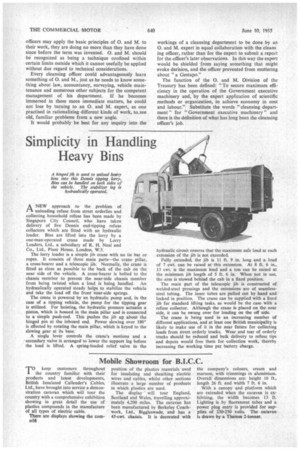Simplicity in Handling Heavy Bins
Page 74

If you've noticed an error in this article please click here to report it so we can fix it.
A hinged jib is used to ialload heavy bins into this Dennis tipping 'lorry. Bins can be handled on both sides of the vehicle. The stabilizer leg is hydraulically operated.
ANEW approach to the problem of unloading refuse from street orderlies and collecting household refuse has been made by Singapore City Council, who have taken delivery of five Dennis end-tipping refuse collectors which are fitted with an hydraulic loader. Bins are lifted into the lorry by a one-man-operated crane made by Lorry Loaders, Ltd., a subsidiary of R. H. Neal and Co., Ltd., Plant House, London, W.5.
The lorry loader is a simple jib crane with no tie bar or rapes. It consists of three main parts—the crane pillar, a cross-bearer and a telescopic jib. Normally, the crane is fitted as close as possible to the back of the cab on the near side of the vehicle. A cross-bearer is bolted to the chassis member to prevent the near-side chassis member from being twisted when a load is being handled. An hydraulically operated steady helps to stabilize the vehicle and take the load off the front near-side springs.
The crane is powered by an hydraulic pump and, in the case of a tipping vehicle, the pump for the tipping gear is utilized. For hoisting, the hydraulic pressure actuates a piston, which is housed in the main pillar and is connected to a simple push-rod. This pushes the jib up about the hinged pin at the inboard end. Power slewing over 180' is effected by rotating the main pillar, which is keyed to the slewing gear at its base.
A single lever controls the crane's motions and a secondary valve is arranged to lower the support leg before the load is lifted. A spring-loaded relief valve in the hydraulic circuit ensures that the maximum safe load at each extension of the jib is not exceeded.
Fully extended, the jib is 11 ft. 9 in. long and a load of 7 cwt. can be raised at this extension. At 8 ft. 6 in., 13 cwt. is the maximum load and a ton can be raised at the minimum jib length of 5 ft. 6 in. When not in use, the arm is stowed behind the cab in a fixed position.
The main part of the telescopic jib is constructed of welded-steel pressings and the extensions are of seamlesssteel tubing. The inner tubes are pulled out by hand and locked in position. The crane can be supplied with a fixed jib for standard lifting tasks, as would be the case with a refuse collector. Although the crane is placed on the near side, it can be swung over for loading on the off side.
The crane is being used in an increasing number of different applications; and at least one British municipality is likely to make use of it in the near future for collecting loads from street orderly trucks. Wear and tear of orderly trucks should be reduced and bulk delivery to refuse tips and depots would free them for collection work, thereby increasing the working time per battery charge,




























































































































































